Side Menu:
'Switch' Claims Analysed
Despite the overwhelming evidence and logic as presented in the previous page, 'switch' proponents will often raise a seemingly large number of questions, doubts, alleged inconsistencies and supposed evidence that has led many to believe the 'switch' is not only possible, but a reality. In fact, those that are not inaccurate, ill-researched, dubious or simply fabricated actually have very simple and logical explanations:
1. Titanic's insurance was increased 5 days before sailing
2. Damage from Olympic's collision with Hawke was more significant
3. Olympic survived too long for a badly damaged ship
4. Olympic had a 2 degree list to port, as did Titanic
5. Only a limited number of changes required for a switch
6. Difference in tonnage
7. 'The Olympic Room'
8. If not insurance, a switch would keep the company operational
9. Difference in Titanic's name plate
10. Difference in number of Titanic's portholes
11. Difference in Titanic's windows on B deck
12. Difference in port side joint plating
13. Discoloured plating on Titanic
14. Olympic's wheelhouse was not curved
15. Names riveted on, not welded
16. Lack of publicity for Titanic
17. Titanic's bulkheads were intentionally deficient
18. Titanic's sea trials were shorter than Olympic's
19. Titanic was not open for the press and public inspection
20. J.P. Morgan and 50 others cancel passage
21. Crewman refused to sail on Titanic
22. Titanic's lifeboats had "RMS Olympic" written on them
23. Titanic was at full steam but not achieving maximum speed
24. Titanic did not strike an iceberg
25. Ice on the deck was not from an iceberg
26. Numerous ships were stationed nearby despite a coal strike
27. Seacocks opened to hasten the sinking
28. Californian was not expecting rockets, but a rendezvous
29. Californian was carrying woolly jumpers and blankets
30. Survivors on B Deck saw lifeboats lowered from above
31. Passengers said there were promenades instead of cabins
32. Linoleum flooring covered with carpets
33. Titanic split at the same point where the Hawke hit.
34. Surviving crew signed the Official Secrets Act
35. Harold Sanderson repeatedly referred to Titanic as Olympic
36. Titanic sailor's deathbed confession of 'switch'
37. The number 401 on Olympic woodwork
38. Olympic's name is on the wreck
39. 401: Titanic's propellor is on Olympic
40. White paint on the wreck
41. Marble in the Sitting Room
42. Ship's Bell with no name on it
43. Bulkhead put on Olympic found in stern wreck
1. Titanic's insurance was increased 5 days before sailing
CLAIM: Titanic's insurance was increased 5 days before the maiden voyage which resulted in J. P. Morgan receiving $12½ million for her, in insurance payouts from Lloyds Maritime Insurance. Estimated at over $160 million today, more than they could ever have recovered if they had sold or scrapped her.
The switch theory primarily rests on the sinking being a deliberate act to recover insurance money, to rescue the White Star Line from bankruptcy. However, as already proven (in this point here) Titanic was in fact under-insured by $2.5 million.
As if somehow to counteract this it has been alleged that 'Titanic's insurance was increased by J. P. Morgan from $5 million to 12.5 million 5 days before her fateful journey'. Some go as far as to state that 'Lloyd's paid out $12,500,000'. But please read this information first, where it clearly shows that the Lloyds records do not agree with this at all. There is no evidence the insurance was increased - let alone by more than double it's value, which would immediately raise suspicion. Ismay went on public record at the April 1912 United States Senate Hearings and also it was reported in the official public findings that the value of Titanic was "$7.5million" a figure independently verified by the New York Times and The Spectator ("$8 million") while insured at only "$5 million" (as reported at the Senate Inquiry, The New York Times and Lloyds itself). If indeed Titanic had been insured at the last minute at "$12.5 million," as is alleged by conspiracy theorists, wouldn't this have raised serious alarm bells in the minds of the insurers at time, especially if it was part of the public record that the value was "$7.5million"? Quite simply Titanic was underinsured, the main reason being that the White Star Line actually insured its own ships.
2. Damage from Olympic's collision with Hawke was more significant
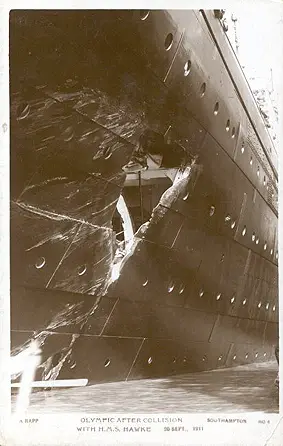
RMS Olympic after the collision
with HMS Hawke.
Another key component of the 'switch's theory is to state that damage to HMS Hawke was much more substantial than what is thought. However, as already discussed here the Olympic's damage from HMS Hawke did not exceed $125,000, and there is independent verification of this fact.
Mark Chirnisde summarises this:
Olympic was damaged badly enough to force the voyage to be cancelled. Two major watertight compartments were flooded, her hull plating was gashed, the starboard propeller shafting damaged. Photos after the collision show the liner down at the stern... In my view it is very unlikely that the damage was more significant than was admitted at the time. The hearings following the Olympic/Hawke collision included a damage assessment of the Olympic which was agreed upon by both White Star and the Royal Navy, and stated that the Hawke’s bow had penetrated eight feet into Olympic’s hull. (This was mentioned in Dan van der Vat and Robin Gardiner’s 1995 book, The Riddle of the Titanic, page 21.) I think it is impossible that the Olympic’s keel was damaged in the collision, as Robin Gardiner speculates in his 1998 book Titanic: The Ship That Never Sank? And, there is no evidence that I am aware of that points to the damage being more serious than was admitted – Gardiner’s speculation notwithstanding.
3. Olympic survived too long for a badly damaged ship
Claim: How can a ship with a bent keel go on to serve 24 years (1911-1935) without being fully repaired?
This line of reasoning goes with the assumption that Olympic's keel was damaged, for which there is no evidence as discussed in the point above. The fact that the Olympic went on to serve 24 years is simply because the damage was repaired. Incidentally, although called 'Old Reliable' her 24 years were not without further incidents either, as she was involved in several more collisions including with the Nantucket Lightship LV-117, causing the lightship to break apart and sink with seven fatalities out of Nantucket's crew of eleven.
4. Olympic had a 2 degree list to port, as did Titanic
Claim: The damage below Olympic's waterline was said to be far more serious as the super structure had warped. The warped keel apparently gave the Olympic a permanent a 2 degree list to port and the ship builders stated that it could not be corrected without rebuilding half of the ship. Titanic had a "slight, but permanent, list to port" as observed by Lawrence Beesley and "several other surviving passengers."
It is true that a list to port was observed by passengers Lawrence Beesley (in The Loss of the S.S.Titanic) and Norman Chambers (US Inquiry). Photographs taken of Titanic leaving Southampton also reveal a slight port list.
However this is not unsual, even for modern ships, and can be due to several factors. In Titanic's case it was likely due to improper ballasting--too much on the port side or too little on the starboard. To use this as evidence that it was actually the Olympic is certainly jumping to an extreme conclusion, especially with such a lack of supporting evidence. As in the previous points we know that damage to the Olympic did not include a 'warped keel'.
This is confirmed by Titanic researcher Ioannis Georgiou, who adds:
"While it is true that some survivors as Beesley and Chambers did speak about a port list, this was taken out of context as both were refering to April 14th. This was the result of difference in the coal consumption and the emptied coal bunker aft of BR 6 and forward of BR 5...The coal bunker was on the starboard side which was emptied. For sure bunker "W" was emptied as this is mentioned by survivors."
Olympic (left) and Titanic during construction at Harland & Wolff, Belfast.
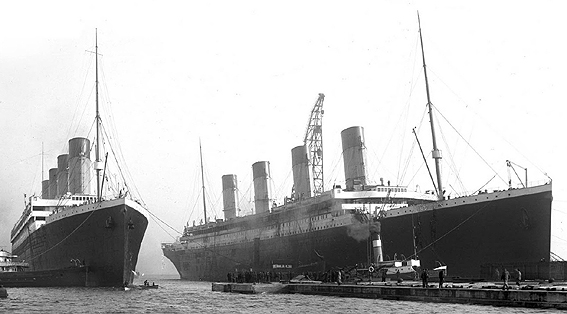
(Click image to enlarge)
5. Only a limited number of changes required for a switch
Claim: All that needs to be done to switch the ships is exchange those parts of the ships which bore the vessels’ names such as name plates, the ships bell, menus and note paper letterheads, the names on the life belts and life boats, also any plaques and brass fittings with the liners name on and any interior signing bearing the name Olympic or Titanic.
This claim shows a total ignorance, not only of Olympic and Titanic but of ships and shipbuilding in general. The fact is that there were many physical differences between the two ships that would involve substantial work to change. The list of differences is discussed on the previous page here. Not to mention the difficulty in changing the shell-plating at the bow and stern which bore the ships’ names - the names weren’t just painted on the plates, they were cut into the plates in letters four feet high and one-half inch deep that were then filled in with paint.
6. Difference in tonnage
Claim: The Olympic was recorded as having a tonnage of around 45,000, while the Titanic weighed in at about 46,000. Plainly put, the addition of 1,000 lbs to the Titanic still resulted in the Titanic weighing 46,000, which doesn’t make a lot of sense. It is very plausible that the 1,000 pounds of tonnage was added to the Olympic in order to meet the weight of the Titanic.
Most references agree that the Olympic of 1911 - 1912 weighed in at 45,324 tons, while her newer sister came in at 46,328 tons. Since they both had the same dimensions, the difference is simply due to revised interior configurations such as Titanic's A Deck promenade which was enclosed by a steel screen with sliding windows, to provide additional shelter, and the promenades on the Titanic's B Deck were reduced in size, and the space used for additional cabins and public rooms, including two luxury suites with private promenades. These differences meant that Titanic had a slightly higher gross tonnage.
However it seems that conspiracy theorists make a deliberate mathmatical error, and then label it 'conclusive evidence'. Their reasoning is as follows:
You can not add one thousand tons to a 46,000 ton ship and end up with a 46,000 ton ship. The vessel which sailed out of Southampton on 10 April 1912 can only have been a 45,000 ton ship with the last minute addition of 1,000 tons of GRT in her B Deck public rooms and enclosed area on A Deck.
Their error is simple: actually Titanic would have been the same tonnage as Olympic i.e. 45,324. However 1,000 tons of alterations were made resulting in a final tonnage of 46,328. There seems absolutely no reason to find any conspiracy here - the difference in tonnage is historical, mathmetical and logical.
7. "The Olympic Room"
Claim: Titanic had a newly named room, "The Olympic Room" because, superstitious shipping merchants believe it is bad luck to change the name on a ship, and J Bruce Ismay, and J.P. Morgan thought it best to have the Olympic's name still somewhere on board.
At present I have found no evidence of a room named "The Olympic Room" on Titanic, however it would not be surprising. Titanic was in fact what White Star Line called "Olympic Class" - so in effect had the name "Olympic" on her already. "Olympic Class" refered to a set of three ships: Olympic, Titanic and Britannic.
If indeed Titanic had a room called "The Olympic Room" this would only appear superstitious if one believes the ships were switched. If not, it is a moot point. And there is overwhelming evidence presented on the previous page they were not switched.
8. If not insurance, a switch would keep the company operational
Claim: White Star never had any intention of scuttling the ship. The swap was purely to keep the company in business.
There are some who acknowledge that Gardiner and others have no evidence of insurance fraud, admitting that Titanic was indeed under-insured, and that the theory that White Star planned to scuttle the ship in a pre-arranged mid-Atlantic collision is simply untennable. Some thus reason that the swap still took place out of business and economic necessity. However this claim goes with the assumption that the White Star Line was suffering financially. While there were costs involved in repairing the damage in the Olympic/Hawke collision, and the fact that the Olympic was out of service meant lost revenue, the fact is that as a business the White Star Line was not going bankrupt and there simply was no need for a 'switch'. This has already been discussed here. Mark Chirnside reports the following:
"The company’s surplus on the profit and loss account had risen from $48,585 in 1910 to $821,062 in the year ending December 31 st 1911. Even if the insurance would not pay out the $750,000, IMM would have remained in surplus. In 1910, IMM’s net profit was a mighty $4,849,580, and this slipped to $4,509,270 in 1911. As for the White Star Line itself, it was ‘the principal constituent’ of IMM and ‘enjoyed continued prosperity, its profit distribution for 1910 being 30 percent’ after depreciation. In fact, White Star’s profit and loss account for the year to December 31 st 1911 was in surplus by £1,102,756 – even higher than IMM’s."
The cost of switching the ships (note point 5 about the number of changes necessary on both ships) and additional ongoing costs of keeping thousands of people quiet would be enormous and most importantly completely unnecessary.
9. Difference in Titanic's name plate
Claim: The name plate of Titanic is longer on the ship as it went on its maiden voyage compared to when it was being built. It was longer as it had to cover up the word Olympic that occupied more space.
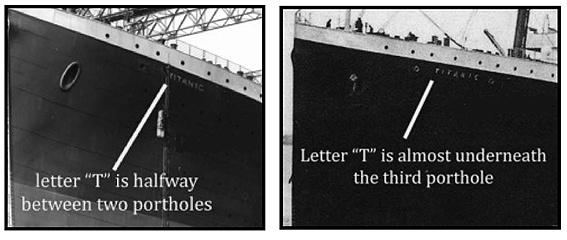
These above images are used by conspiracy theorists alleging a difference in the length of Titanic name's hinting at a coverup.
The answer to this is very simple: The name during her building and her sailing are in partly different positions because in the first construction image it was written over on the negative. During her construction and in this particular photograph the name was not very clear so the photographer took the liberty of sketching it in, which was not an unsual practice of the day. There are other photographs of Titanic with similar liberties such as the shot of her in Cherbourg at night which has been heavily doctored to look it was taken at night with her lights blazing.
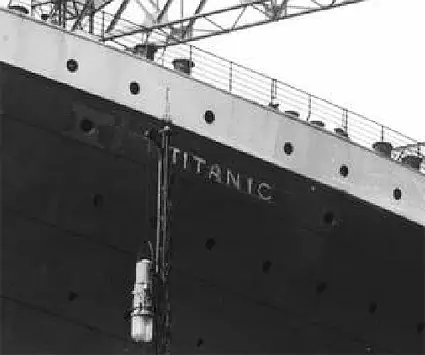
The reality: In close up we can clearly see that the name Titanic was
actually sketched on to the negative/photograph to make it more visible
and so cannot be used for reference. (Click image to see full photograph)
Sorry, no evidence of conspiracy here, just a touched up photograph.
10. Difference in number of Titanic's portholes
Claim: Titanic had 14 bow portholes. Olympic had 16 bow portholes. The ship photographed departing Southampton has 16 bow portholes. It is the Olympic, not Titanic.
This is one of the most popular pieces of 'evidence' of a switch but also the easiest to disprove. Quite simply, Titanic had 14 portholes on the port side C deck (bow) when launched, but in the following months she got 2 extra for better light and air. In fact both Olympic and Titanic were launched with 14 portholes on the port side forecastle on C-Deck and 15 portholes on the starboard side of the same area. However, in December 1911, during Titanic's fit out, she had 2 added to light the crews galley and wash room which resulted in a total of 16 as seen in the maiden voyage photographs. Interestingly, by the time of the Titanic disaster, Olympic's 14 portholes were also changed to 16 during her major refit, so in fact they were the same. Hence post-Titanic-sinking images of Olympic also have this 16 porthole configuration.
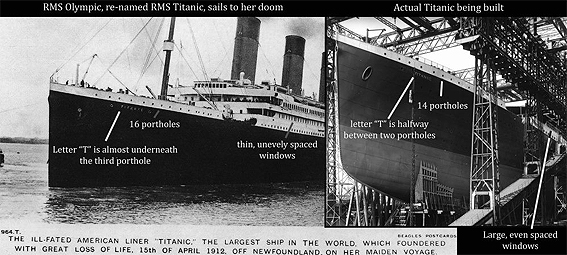
These above images are used by conspiracy theorists alleging a difference in portholes. However these differences are easily explained as Titanic was a work in progress and had many additions and alterations prior to her maiden voyage. (Click to enlarge)
It must be pointed out that only the hull of Titanic was launched with a basic superstructure. Once it was launched then it was 'fitted out' i.e. everything else was added. The ships that were launched were not launched in a finished state. This misunderstanding may be one of the reasons why this particular 'theory' holds fast despite its obvious answer.
According to Titanic researcher Ioannis Georgiou, "The two additional potholes on Olympic were added about March 1912 during her short stay in Belfast and before the maiden voyage of Titanic. So by April 1912 both ships had 16 portholes. (This is something I have noticed.)"
One must also suggest - if those behind the 'switch' were so clever so as to be able to switch absolutely everything aboard Olympic/Titanic as to include the numbers 400/401 etched onto the back of wooden panels in all the state rooms (refer to point here) then how is it they would overlook something as simple as the number of port holes on the outside of the ship?
11. Difference in Titanic's windows on B deck
Claim: Also, at Titanic's launch, all of the windows on B-deck were evenly spaced out, yet on her maiden voyage they were seen as being unevenly spaced, just as Olympic's were.
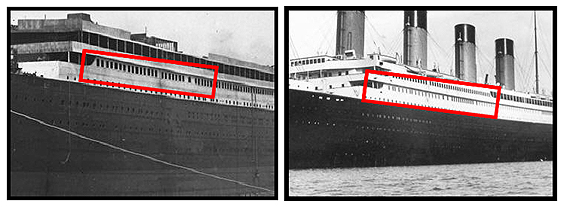
These above images are used by conspiracy theorists alleging a difference in the windows on B-deck -which should not be surprising as two private verandahs and suites were added to this section of the ship after it's launch.
This claim is often mentioned alongside the above claim about the apparent discrepancy in the number of portholes on Titanic's port side bow. And the answer is the same. Titanic was a work in progress, designed to be a better, improved version of her older sister Olympic. The difference in windows on B-deck between the time of her launch and her maiden voyage is explained by one of the key differences between the two ships: instead of a promenade as on Olympic's B deck, two private verandahs and suites were added to Titanic, hence necessitating a change in the B deck window configurations.
12. Difference in port side joint plating
Claim: Olympic had a vertical joint in her hull plating immediately forward of the port side anchor hawse pipe, while Titanic during her construction did not. A post disaster image of Olympic shows the plating joint has disappeared, revealing she is in fact Titanic.
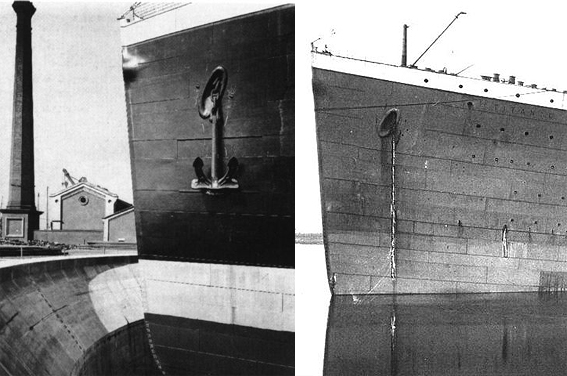
Above left: Olympic taken when the vessel was in the Thompson Graving Dock in 1911, allegedly shows her to have had a vertical joint in her hull plating immediately forward of the port side anchor hawse pipe.
Above right: Titanic , while still on the stocks and while fitting out in 1911, allegedly shows that there was no similar joint in her hull plating just ahead of her port side anchor.
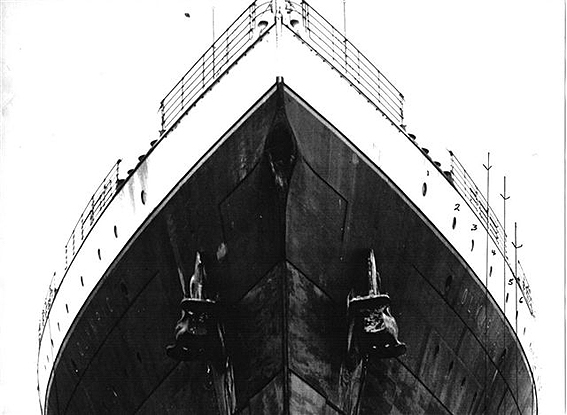
Above: Olympic, taken during her 1912/13 refit following the Titanic disaster, allegedly shows the vessel without the tell-tale plating joint.
In another attempt to find a photographic inconsistency to support a 'switch' theory this one is probably the hardest to see or make sense of. It involves 3 photographs. Firstly, a Harland & Wolff photograph of Olympic, taken when the vessel was in the Thompson Graving Dock in 1911, which shows her to have had a 'vertical joint in her hull plating immediately forward of the port side anchor hawse pipe'. The second photograph is of Titanic, while still being fitting out in 1911, which shows no similar joint in her hull plating just ahead of her port side anchor. Thirdly, in a picture of Olympic, taken during her 1912/13 refit following the Titanic disaster, this allegedly shows this vessel not to have the 'tell-tale plating' joint, which to 'switch' proponents proves 'conclusively' that the hull pictured is that of Titanic although the name Olympic is clearly visible on both sides of the bow.
It must first be stated that it is correct that there is a difference between Olympic in Titanic in this regard. According to Steve Hall and Bruce Beveridge's book "Titanic or Olympic, Which Ship Sank?" Olympic had an "overlap of the plates, or strakes" forward of the bow anchors (described as "the doubler forward at the bower anchors), while Titanic was different in that "the strake butted up against the doubler and did not overlap it."
So does the post-disaster image of Olympic show the "doubler" overlapping or not? Well it first must be noted that compared to the other images of Olympic and Titanic, this post-disaster image has the anchors stowed, thus obscuring this area of interest. Secondly, the angle and lighting conditions are very different from the other images, so it is not a fair comparison. Hall and Beveridge note in regard to this photograph that although "the overlapped doubler is hidden behind the stowed anchor, the shadows of the butt lap is still discernable." If 'switch' conspiracy theorists believe this is the smoking gun of a switch then they absolutely need more than this very doubtful photograph to prove that Olympic's "doubler" is not overlapping and hence it is actually Titanic.
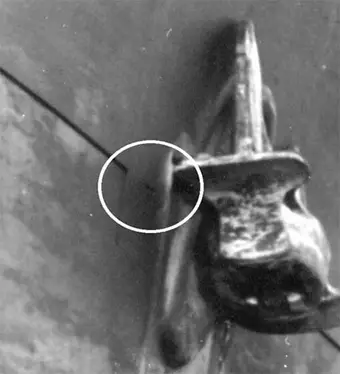
In this close up of the post-disaster image of Olympic
Hall and Beveridge
note in regard to this photograph that although "the overlapped doubler
is hidden behind the stowed anchor,
the shadows of the butt lap is still
discernable." Hence it is Olympic, not Titanic. Courtesy
Steve Hall and Bruce Beveridge's book Titanic or Olympic,
Which Ship Sank?
13. Discoloured plating on Titanic
Claim: Photographs taken of Titanic at Southampton shortly before her maiden voyage show a large area of discoloured plating, as if it had been newly painted with paint that did not quite match the original, in the same location as Olympic's hull was damaged by HMS Hawke.
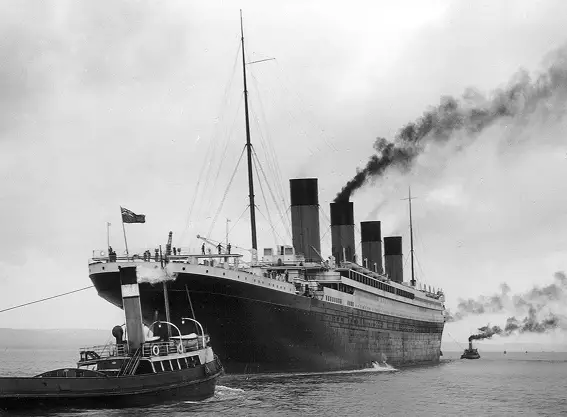
This photograph of Titanic leaving Belfast on her way to begin sea trials allegedly reveals discoloured plating in the same location where Olympic had damage after its collision with HMS Hawke. Compare it with the damage photograph below. (Click to enlarge)
Take a look at the two photographs and compare for yourself. I can see no credible evidence of discolouration that would be proof positive of repair work. Any discolouration could be explained as being due to lighting conditions and/or photographic imperfections. There is nothing here on which to base a 'switch' theory.
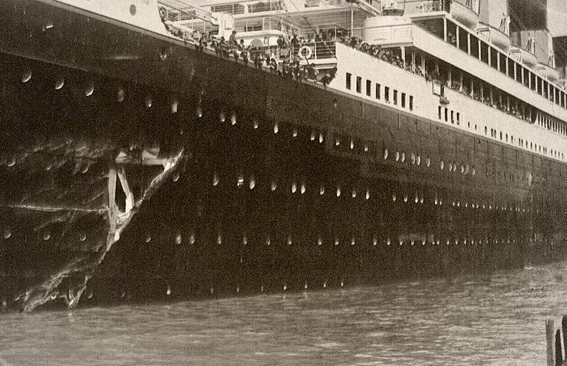
Damage to the Olympic due its collision with HMS Hawke. (Click to enlarge)
14. Olympic's wheelhouse was not curved
Claim: While the wheelhouse of the Olympic was allegedly constructed in a bow fronted fashion, a photograph taken from the top of the huge steel gantry appears to show a straight fronted wheelhouse, exactly as it appeared on earlier drawings of the ship.
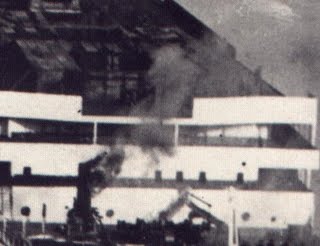
This is supposed to show Olympic's wheelhouse
as being straight rather than curved.
The photograph "taken from the top of the huge steel gantry" of Olympic during her construction as seen above is supposed to prove that Olympic's wheelhouse was in fact straight (as it is on the Titanic wreck). However the key problem with this is that at the time of launch the wheelhouse had not yet been constructed. The only thing which can be seen in this photo is the straight fronted officers quarters.
The two photographs below are far better (and easier to see) examples of the wheelhouse under construction and then aboard Olympic in 1911. Both clearly show the wheelhouse to be curved. As already discussed on the previous page here the wheelhouse on the Titanic wreck is definitely rectangular. So no evidence here of a 'switch'.
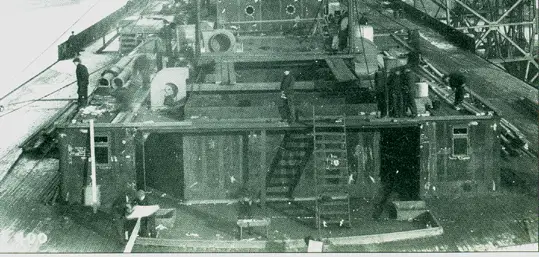
Above: Olympic in the fitting out wharf with construction of the wheelhouse just beginning. The base of the wheelhouse, showing its outline, is clearly curved
(photo courtesy Bob Read/TRMA).
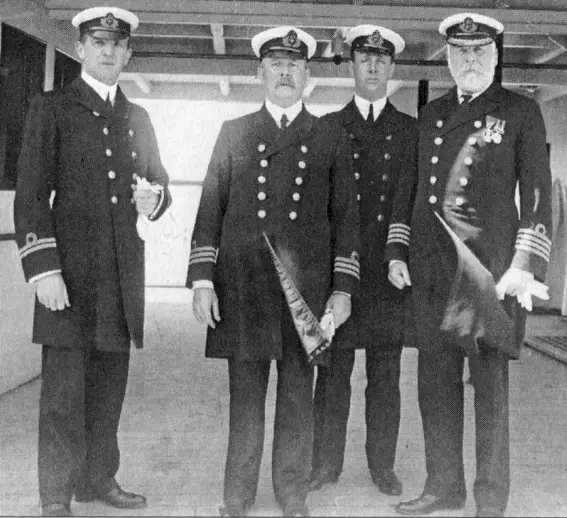
Captain Smith and Olympic's senior officers stand in the bridge area with the curved wheelhouse clearly behind them, left of picture.
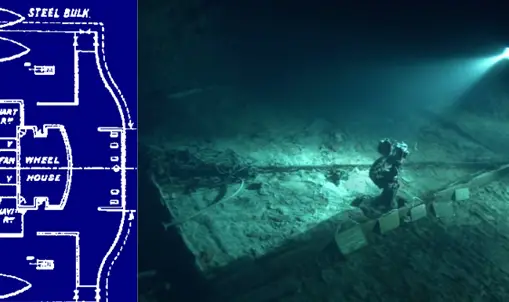
Olympic's wheelhouse in 1912 was curved at the front (left diagram) while Titanic's was straight. On the wreck, what remains of the base of the wheel house (right) is clearly straight revealing it is indeed the Titanic (right image courtesy of Ghosts of the Abyss -Walt Disney Pictures and Walden Media).
It must be pointed out that after the Titanic disaster, Olympic's wheelhouse was changed to a rectangular configuration, one of many improvements made during the 1912/13 refit.
15. Names riveted on, not welded
Claim: As welding had not yet been invented, it was customary for White Star Line to etch or cut the names of their liners into the steel and not rivet them to the outside. However both RMS Olympic and RMS Titanic had their names riveted on...covering something up perhaps?
This is one of several undocumented, unreferenced claims. Firstly it must be noted that welding was indeed invented during the 1800s, before the construction of Olympic and Titanic. Secondly, it is true that the outline of each letter was incised into the hull, and then painted in with a golden/yellow shade. This was standard White Star Line practice. However there is absolutely no evidence Olympic or Titanic ever had their names "rivited on". This is demonstrably false information. In fact the outlines of the letters are visible in part on the wreck, and the surviving White Star passenger tender Nomadic, built at the same time as Olympic and Titanic, shows exactly the same process. There were no plates or anything that could be swapped over- the name was literally engraved into the ship, then filled in with paint.
Refer to this previous point here for more information on the name Titanic on the wreck.
16. Lack of publicity for Titanic
Claim: Historians have always mused that it was rather strange that Titanic was never shown the enormous publicity that Olympic received the year before. "It was a somewhat quiet affair."
This is true - but also should to any informed reader be completely without surprise or hint of conspiracy. Olympic was the first to be launched, pronounced the largest and most luxuriest ship in the world. By the time Titanic's maiden voyage came along Olympic had been operating for a year. Titanic, although only just superceding her sister in size, was no longer big news and so the public and media were not as interested in her maiden voyage as that of her sister. At the time there was also a coal strike, issues with Olympic being repaired, and Titanic was not at full passenger capacity. There was nothing particulary newsworthy about her. It was only when she collided with an iceberg in a freak set of circumstances that she was suddenly thrust back into the media spotlight. Due to the lack of media coverage of her deparure many outlets resorted to using photographs and footage of Olympic, leading to much confusion over the subsequent years.
17. Titanic's bulkheads were intentionally deficient
Claim: The unsinkable ship somehow had to become sinkable...very sinkable. The bulkheads were not actually sealed at the top, this oversight allowed water to flow over, filling each compartment, one at a time. Did J. P. Morgan and J. B. Ismay know this?
It is true that Titanic's bulkheads did not extended to the 'top' and were also not 'sealed' at the top, for a number of reasons. Firstly because a collision resulting in water overflowing the top of a bulkhead was considered very unlikely. Also a sealed design would have restricted access to certain parts of the ship and impacted on the larger open spaces dictated by a ship aiming for luxury, instead of being a watertight battleship. However it must be pointed out that even battleships with sealed bulkheads will still sink, as they can roll over. So higher or sealed bulkheads would not necessarily have prevented Titanic from sinking, but would have slowed the rate of sinking.
To presume that Ismay or Morgan had created an intentional design fault is simply absurd for one simple reason: the bulkhead design is the same for both the Olympic and Titanic, so in other words was designed and constructed years in advance of the Hawke collision that would supposedly justify a 'switch' scenario. Morgan and Ismay would have to be fortune tellers as well as fraudsters!
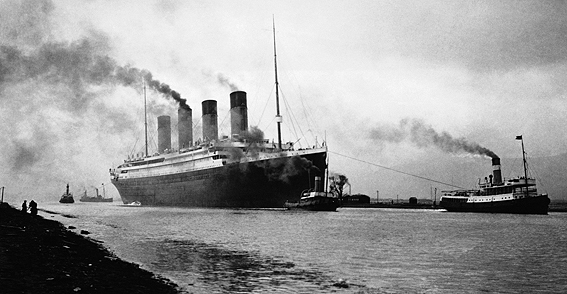
Titanic being towed out to her sea trials.
18. Titanic's sea trials were shorter than Olympic's
Claim: Olympic's trials in 1910 took two days, including several high speed runs, but Titanic's trials reportedly only lasted for one day, with allegedly none over half-speed. This was because Olympic's patched-up hull could not take any long periods of high speed.
It is true that Titanic's seal trials were half that of Olympic's. But they were cut short for several good reasons. Firstly, they had been postponed for a day due to bad weather. Secondly, there was a rush to get the ship to Southampton to begin provisioning for the maiden voyage. Thirdly, the characteristics of the Olympic were already known so there was less of a learning curve to deal with. The Titanic was carefully inspected nearly every day during her construction and again after making it to Southampton. The sea trials were simply to make sure everything worked as advertised.
As to Gardiner's claim that “Titanic” -actually the Olympic - never traveled faster than one-half her designed top speed, as her damaged hull was too weak to endure the stresses of a prolonged high-speed run, there is absolutely no documented evidence to support this. Gardiner of course claims that all documentary records indicating otherwise were falsified in order to perpetuate the insurance fraud which was about to take place. However he conveniently does not explain how in just four and one-half days the Titanic reached the position where she sank if she was never able to travel at more than 12 knots!
19. Titanic was not open for the press and public inspection
Claim: While Olympic was open for inspection by the press and public in both Belfast and Southampton, Titanic was not open for any inspection at all, except to The Board of Trade inspection.
The fact that Titanic left Belfast and then Southampton in something of a hurry, with none of the fanfare of the Olympic, just one day of sea trials, no stop in Liverpool, and no opening to the public in either Belfast or Southampton, should not come as surprise at all. Under the circumstances it is perfectly logical. Mark Chirnside explains:
The maiden voyage had been postponed by three weeks in October 1911, as workers were diverted to repair Olympic; it was always going to be ‘tight’ to meet the April 10th 1912 date, and when we consider that Titanic’s trials were postponed for a day due to bad weather it is not odd at all... Since finishing touches were still being put to the ship’s accommodation, it’s hardly surprising that the public was not allowed onboard at Southampton.
Also, as discussed in point number 16 above, there was less interest in Titanic's maiden voyage, as her older sister had proceeded her. But also it must be noted that there were tours of Titanic prior to her departure on her maiden voyage. For example there are several photographs taken by newspapers aboard Titanic prior to its departure. Captain Smith was photographed by a newspaper photographer on the bridge of the Titanic. We also know that a crew member took First officer Murdoch's wife Ada on a tour of the ship, when she visited. So the public and media were certainly not barred from touring her prior to her voyage.
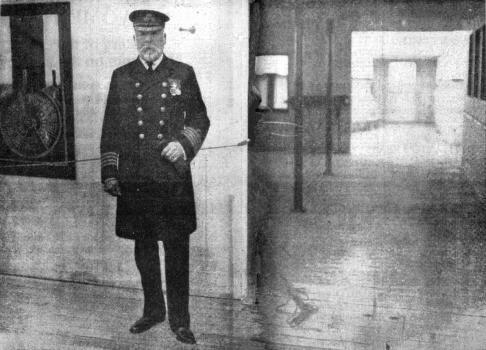
Captain Smith posing for one of Southampton's local
newspapers shortly before Titanic's sailing day.
20. J.P. Morgan and 50 others cancel passage
Claim: More than fifty first class passengers cancelled at the last minute, many of them friends and business associates of JP Morgan, and Morgan himself (who had money tied up in the White Star Line) also cancelled claiming that he was ill. Morgan was found two days later by a reporter in good health at a French resort with his mistress. Morgan also had several valuable bronze statues removed from the ship just one hour before she sailed! Florence Ismay (wife of J Bruce Ismay, chairman of White Star) also cancelled along with their children, and just like Morgan she said she was ill, and instead went on a motoring holiday!
There is no reason to doubt that passengers cancelled their voyage aboard Titanic. However the way in which it is painted to look part of a conspiracy theory is unfair and disingenuous at best. Firstly, Ismay's wife and children did not cancel at the last moment. According to Don Lynch and his book "Titanic: An Illustrated History" they did not accompany him on the maiden voyage because ‘they had instead chosen to spend the time on a motor holiday through Wales.’
Secondly cancellations of this nature are not unusual on voyages; similar happened to the Olympic's maiden voyage. Mark Chirnside states:When the Titanic sailed on her maiden voyage in April 1912, the number of passengers that she was carrying was very similar to the number that were booked onto Olympic for her maiden voyage the year before. It’s natural that there will be cancellations and while more than fifty might sound like a high number it’s hard to see that there is much significance in this fact as regards the switch theory... If a number of people had cancelled because of some sort of fear of a switch or insurance scam going on, it is seems very likely that they would have spoken out after the disaster. There is no record of anyone doing so.
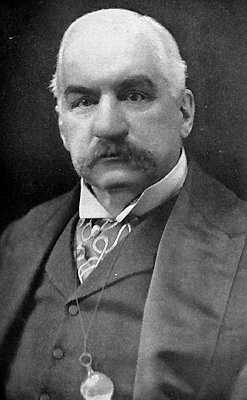
John Pierpont Morgan
In regard to J.P. Morgan cancelling "at the last minute" research by Mark Baber and posted on Encyclopedia Titanica actually reveals it to be an urban myth. Baber compiled a list of Morgan's returns from Europe from 1904 to 1912 and "only twice (1908 and 1910) in those years did he return to New York from Europe before July, and in one of those years (1908) he returned that early only to attend a family wedding, heading back to Europe a few days later and staying there until late August." And those occasions he returned early were in June -never as early as April. Even more conclusively, a New York Times newspaper article of Thursday 28th March 1912 reveals that in March "J. Pierpont Morgan has written a cordial letter to the committee, announcing that he will be in Venice on April 23 for the inauguration of the biennial International Art Exhibition, April 25, and dedicate the new Campanile of St. Mark's." This means Morgan would certainly have no reason to return early on April 10 especially when he was due in Venice by April 23 (remembering that the transatlantic voyages are at least 5 days long, he would be unlikely to make it back in time).
21. Crew refused to sail on Titanic
Claim: A large proportion of the engine crew signed off just prior to the ill fated voyage starting from Southampton, during a coal shortage which meant that many sailors were out of work due to their ships being laid up. Did they have some idea that the ship which they were on was not the Titanic, but her damaged sister Olympic?
Claims for this range from "two of the firemen, boiler stokers and greasers" to "a large proportion of the engine crew" to the specific number of 173 who 'prefered to wait for employment on another ship.' Some also claim that the reason some crew did not sign up was specifically because 'the only thing that could not be made to look new were the ships boilers, having already been used for 12 months on Olympic before the switch' and noticing this on the Belfast to Southampton crossing they decided to 'get off' at Southampton. While there is a noticeable lack of specific documentation or references to prove this, it would actually not be surprising that some -maybe even a large number- did not sign up. And for a rather simple reason that has nothing to do with a conspiracy theory but common sense. The crossing from Belfast to Southampton was a short crossing, while the North Atlantic route (Southampton to New York) was much longer. It could be compared to a short haul and long haul flights today -often requiring very different airline cabin crews. The crew aboard Titanic from Belfast to Southampton were local operators ("runners") who mostly worked on voyages that were made locally, and did this with a number of ships, not just Titanic. They would not necessarily be interested in the transatlantic route as it would mean not returning to Belfast or Southamopton for several weeks. They would only be interested in shorter crossings.
And they were not "in the middle of a coal strike". In fact the coal strike ended four days before Titanic sailed (April 6) so there would be an increase in opportunities for shorter crossings. But most tellingly, if indeed "a large proportion of the engine crew" refused to work aboard Titanic because of rumours of a 'switch,' then why did these crewmen not speak out, especially after the disaster? Clearly there is no evidence of a 'switch' to be found here.
22. Titanic's lifeboats had "RMS Olympic" written on them
Claim: Titanic's lifeboats had small brass I.D plaques screwed on them and they all said "RMS Olympic"
The story goes that after the sinking thirteen lifeboats were recovered, taken to New York, where the name Titanic was sanded off and numbers removed to deter souvenir hunters. During this process workers allegedy discovered the name Olympic 'carved into the gunwhales,' as 'the old name had been filled with putty and painted over.' the boats were returned to England and reused, however boat no.12, considered an unlucky thirteenth (presumably the thirteenth lifeboat recovered by the Carpathia and so deemed ‘unlucky’ ), was not reused until after the First World War when the boat was handed over to the Sea Scouts as a thank you (some Sea Scouts having joined the Navy during the war and lost their lives). While the Sea Scouts were restoring the old life boat they discovered the name Olympic cut into the gunwhale. The lifeboat was wrecked in a collision with the Gosport Ferry at Portsmouth and taken by the Royal Navy to Haslar for demolition. For many years afterward its port and starboard White Star insignia were used as prizes by a local Sea Scout group.
There are two key issues with this story. First and foremost there is no documented evidence to verify it. Considering the discovery of Olympic's name on the lifeboat(s) allegedly occurred at least twice, on different continents, and no doubt seen by at least several people, why there are no written accounts, sketches or photographs of at the very least the boat, let alone the discovery, should ring alarm bells in the mind of any serious researcher. Secondly, and rather importantly, the names were not engraved on the lifeboats. They were metal plates which were screwed on. They were also not on the gunwhales but on the sides of the lifeboat.
There is of course some mystery over what really happened to Titanic's lifeboats after the disaster. But according to Titanic researcher Ioannis Georgiou "none of Titanic's boats were reused by the White Star Line. The claim that Olympic got them is absurd. The boats were left until December 1912 in New York. By that time Olympic was at Belfast and underwent a major refit which also included new davits and new lifeboats which were larger than the previous lifeboats."
23. Titanic was at full steam but not achieving maximum speed
Claim: The ship was going full steam, but was achieving only 21 knots, rather than its theoretical maximum of 23, despite the Atlantic being exceptionally calm on the night of the sinking. This is consistent with the damage previously sustained by Olympic.
Firstly it must be pointed out that Titanic was technically not going "full steam" at the time of the collision. Titanic's speed was investigated by Mark Chirnside and Samuel Halpern in their article entitled "Speed and More Speed" from which the following information is taken. According to Bruce Ismay's testimony before the British Wreck Commission they planned to increase the number of revolutions some time on Monday or Tuesday to 78, which he claimed would drive the ship at her full speed if the weather cooperated. This is his testimony:
“I understand it has been stated that the ship was going at full speed. The ship never had been at full speed. The full speed of the ship is 78 revolutions. She worked up to 80. As far as I am aware she never exceeded 75 revolutions. She had not all her boilers on, none of the single-ended boilers were on. It was our intention if we had fine weather on Monday afternoon or Tuesday to drive the ship at full speed.”
Leading Fireman Frederick Barrett testified before the British Wreck Commission that on the day of the collision 3 additional double-ended boilers were lit up about 8 a.m. (although they take 12 hours before they are put online) and he was sure that the ship’s five auxiliary single-ended boilers in Boiler Room No. 1 were never lit at all. He also confirmed that the ship was doing seventy-five revolutions, not 80 as was possible.
Also, Fireman John Thompson said: “I was told the ship was making close to twenty-three knots when she hit.” Chirnside and Halpern discovered that "Titanic’s 546 mile run from noon Saturday to noon Sunday would be her best posted performance, only two miles shy of Olympic’s best ever maiden voyage daily run, and she did that with only 21 of her 24 double-ended boilers connected up." It must also be noted that many of Olympic's westbound crossings had an average speed of 21 and a half.
Chirnside and Halpern conclude: "There is no doubt that Titanic’s speed was increased steadily throughout her maiden voyage, revolutions were increased, boilers brought online, and preparations were being made to further increase the ship’s speed. Early on, she was broadly running level with Olympic’s performance on her maiden voyage, and as the speed increased, Titanic was well placed to exceed her sister’s average speed."
In summary Gardiner's allegations that Titanic was in fact a damaged Olympic struggling to maintain speed does not add up, especially when you consider that he alleges that the damaged Olympic had a broken keel and could not make half speed during the sea trials.
24. Titanic did not strike an iceberg
Claim: Since an iceberg could not inflict such damage on a steel double-hulled vessel such as the Titanic, it must have hit something else, in this case an IMM rescue ship that was drifting with its lights out.
This is where Gardiner's theory starts to get even more bizarre. Not content with an insurance scam 'switch' he also proposes that Titanic (really Olympic) hit, not an iceberg, but an IMM rescue ship that was drifting with its lights out. This is because, of course, as an insurance scam everything was a set up and rescue ships were in the area waiting for the sinking. Gardiner bases this hypothesis on the idea that the supposed iceberg was seen at such a short distance by the lookouts because it was actually a darkened ship.
There are two keys errors in this hypothesis. Firstly Titanic was not a "steel double-hulled vessel". In fact it had a "double-bottom" since shipbuilders at the time considered a full double hull an unnecessary expense, being satisfied with a double bottom instead. After the Titanic disaster this all changed. So there is nothing surprising with the fact that an iceberg caused enough damage to the starboard side (not bottom) of the hull so as to breach watertight compartments that eventually led to its sinking.
Secondly, there are many eyewitness accounts and descriptions of an iceberg. These include: Lookout Fredrick Fleet, Quartermaster George Rowe, Quartermaster Alfred Olliver, Edith Rosenbaum, George Rhiems, Albert Dick and Vera Dick and William Sloper. And they were not the only ones. Survivor Lawrence Beesley wrote about men in the smoking room sighting the iceberg in his book, "The Loss of the SS Titanic":
"One of them had seen through the windows an iceberg go by towering above the decks. He had called their attention to it, and they all watched it disappear, but had then at once resumed the game. We asked them the height of the berg and some said one hundred feet, others, sixty feet; one of the onlookers — a motor engineer travelling to America with a model carburetter (he had filled in his declaration form near me in the afternoon and had questioned the library steward how he should declare his patent) — said, "Well, I am accustomed to estimating distances and I put it at between eighty and ninety feet."
25. Ice on the deck was not from an iceberg
Claim: The ice on the deck of the Titanic is explained by Gardiner as ice from the rigging of both the Titanic and the mystery ship she hit.
This claim is of course connected to the previous claim that the ship hit, instead of an iceberg, an IMM rescue ship that was drifting with its lights out. One issue with this theory is that there are many passenger accounts of large quantities of ice, more than what could be explained by what would fall from rigging onto the deck, such as the following
- Able Bodied Seamen William Lucas saw "about a couple of tons...On the fore-well on the starboard side." (British Enquiry (Day 3)
- Able Bodied Seaman Edward John Buley also reported ”a couple of tons of block ice” (British Inquiry (Day 16).
- Able Bodied Seaman Joseph Scarrott "there was a large quantity of ice and snow on the starboard side of the foredeck
- Fourth Officer Boxhall "a little ice in the well deck covering a space of about three or four feet from the bulwarks right along the well deck, small stuff.” (British Enquiry,Day 13)
- Leading Fireman Charles Hendrickson (British Inquiry, Day 5). saw ”a lot of ice...on the deck”
- Lookout Reginald Lee at the British Inquiry (Day 4) ice " fall inboard. This is where it landed, just on that forewell deck.
- Able Bodied Seaman Thomas Jones testified before the US Inquiry (Day 7), that he went on deck and could see ”some ice”.
- Lawrence Beesley "the forward deck was covered with ice that had tumbled over" ("The Loss of the SS Titanic")
Also several other passengers such as Lady Duff Gordon and Edith Rosenbaum reported ice on the deck. But most tellingly, there is not one eyewitness account of ever seeing ice in the rigging. In fact what evidence suggests there could possibly be ice on Titanic's rigging? Why would it be there? They were only just entering the icefield. And how much ice would be on rigging anyway? Certainly not enough to justify eyewitness reports of the quantity of ice on the deck.
26. Numerous ships were stationed nearby despite a coal strike
Claim: Numerous ships were stationed nearby, despite a coal strike, to take off the passengers, which is why the shortage of lifeboats would not matter.
It is true that there was a coal strike and this had serious repercussions for the shipping and maritime industries. It began in January of 1912 and was the first national strike by coal miners in Britain, with the main goal securing a minimum wage. After a million men had walked out for 37 days the government intervened and ended the strike by passing a minimum wage law. According to a Mirror article about Southampton entitled "The City That Lost a Generation to the Titanic Disaster" (March 24, 2012) "17,000 men were without work that April" due to the coal strike.
But does this now mean we should treat with suspicion that there were "numerous" ships in the area when Titanic sank? There are a couple of important points to first realise.
Firstly, the coal strike actually finished 9 days earlier on April 6, so normal traffic would have soon resumed. Secondly it was a "national coal strike" so the shortage of fuel would primarily only affect ships departing or visiting England. Thirdly, the description "numerous" is very misleading. Actually there were only 6 within a 140 mile radius. They were:
Californian (19 miles) a Leyland Line, Westbound London to Boston
Mount Temple (50 miles) Canadian Pacific Steamship Company cargo ship, Westbound, London to St. John's, Newfoundland
Parisian (50 miles) Allan Line, Liverpool, England, Westbound, Glasgow - Halifax - Boston
Carpathia (58 miles Cunard Line, Eastbound: Left New York Tuesday, Gibraltar and Mediterranean ports
Birma (70 miles) Russian East Asiatic Company Eastbound, New York-Rotterdam-Libau
Frankfurt (140 miles) Norddeutscher Lloyd Line Eastbound, Galveston to Bremerhaven
Note that of these 6 vessels, 3 were travelling west and 3 were travelling east. Those travelling east bound logically did not depart from England, and so were relatively unaffected by the coal strike. So that makes it 3 vessels in the area. Hardly "numerous" or warranting any suspicion, especially considering Titanic was sailing a popular North Atlantic route, known to be busy at that time of year.
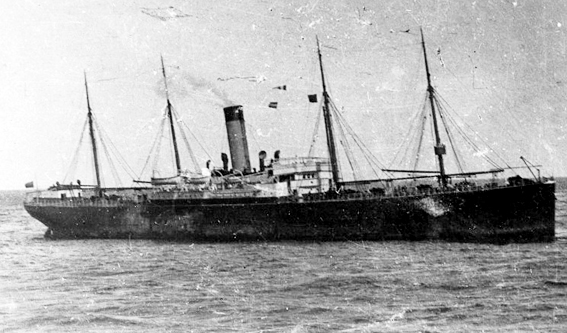
S.S. Californian.
27. Seacocks opened to hasten the sinking
Claim: To sink the "Titanic" (really Olympic) the original plan was to actually open the seacocks to slowly flood the ship and await rescue.
According to Gardiner the original plan to pull off the sinking after the switch was to slowly flood the ship by opening the seacocks. The collision with an "iceberg" (or what Gardiner believes was an "IMM rescue ship") interrupted this original plan. It has to be admited that this is plain bizarre and shows at what lengths some will go to try and justify a conspiracy. Obviously realising that planning a collision in the North Atlantic would be too difficult and improbable Gardiner uses this to allege a more deliberate and logical plan.
However it is definitely not logical. Firstly, how would White Star believe they could pull something like this off when no doubt hundreds of crew would see water pouring into the ship through the seacocks. Did they think they would just stand there and watch? Additionally, especially as the ship was being labelled "practically unsinkable" how would they explain this 'mysterious' flooding to the inquiries that would no doubt take place afterward? For a company that has miraculously been able to switch ships including hundreds of thousands of numbers on the back of wooden panels, without anyone knowing, this seems a rather farfetched and unlikely plan. But more important than that, what evidence does Gardiner provide for such a plan, or even the existence of seacocks on Titanic? Of course there is none. It is pure speculation about a 'switch' that didn't happen.
28. Californian was not expecting rockets, but a rendezvous
Claim: The Californian was sent to rendezvous with Titanic and collect the passengers after the intentional sinking
The evidence Gardiner and others use to promote the idea of the Californian being a 'rescue ship' is that firstly, it was owned by J.P. Morgan (a "major figure at White Star"), left London in a hurry (as it could only do 12 knots and had to get there first) and was mysteriously sailing during a coal strike (when coal would have been more expensive) . They also question why on the night of the collision the captain of the Californian decided to sleep fully clothed on a five and a half foot couch in the chart room and ordered that her boilers be kept fired up and the engines on standby. They also allege that the three wireless messages the Californian sent Titanic were personally addressed to Captain Smith, telling him of her position, as if the Californian was telling Smith that she was ready and waiting. Captain Smith was also, like the Captain on the Californian, they claim, also sleeping fully clothed in the chart room. It was also carrying no passengers, at a time when due to the coal strike and so many ships confined to port there would be plenty of people eager to pay above the cost in cash to get to Boston. Gardiner further hypothesizes that the ship that was hit by the Titanic was the one seen by the Californian firing distress rockets, and that this explains the perceived inaction of the Californian (which traditionally is seen as failing to come to the rescue of the Titanic after sighting its distress rockets).
However there are several large issues with this theory. First and foremost is that the Californian would be a ridiculous choice as a rescue vessel. She had a total capacity of 47 passengers and 55 crew members. Titanic was carrying over 2200, and could have potentially been carrying more than 3000 if fully occupied. Even if that simple fact is not enough, the other alleged details regarding the Californian are being misrepresented. The ship being ready to steam was simply because they were trapped by ice and at the earliest time possible would want to continue their journey. The longer they were at sea, the more money it cost. And as for both Lord and Smith sleeping "full clothed" that is pure speculation, and has little relevance anyway. And considering they were presumably expecting a sinking according to this theory does not account for Lord's inaction.
29. Californian was carrying woolly jumpers and blankets
Claim: The Californian had a cargo of a few thousand woolly jumpers and blankets, as if they were ready for a rescue mission.
While the Californian was primarily designed to transport cotton, there is absolutely no evidence that it had a "cargo of a few thousand woolly jumpers and blankets." The fact is that the Californian's cargo manifest does not exist. To prove this claim a manifest needs to be presented (and in the grand scheme of things and the overwhelming evidence a 'switch' did not take place would prove very little anyway).
30. Survivors on B Deck saw lifeboats lowered from above
Claim: Survivors on B Deck described seeing lifeboats being lowered from above, there’s no way they would have seen that on Titanic – only on the ship Olympic.
Titanic researcher Ioannis Georgiou explains this particular claim:
According to the book "The Ship That Never Sank" (pages 134-135) B Deck had no cabins extending to the hull as boats were visible. Gardiner argues that when on the port side boat No. 12 was lowered a French man jumped in from B Deck. He continues that on the starboard side Steward Wheelton met Thomas Andrews on B Deck and that the boats were visible from the corridor on B Deck.
In both cases Gardiner made this claim up!
Able Bodied Seaman Frederick Clench who was in lifeboat No. 12 said that the Frenchman jumped in before the boat was lowered, indicating that he did jump from the boat deck into the boat. [American Inquiry, Day 7] There is no mention that he jumped in from B Deck. A few passengers, 2nd Class passenger Lillian Bentham and Emily Rugg reported that someone jumped it from a upper deck which might have been A Deck.
1st Class Steward Edward Wheelton did met Thomas Andrews on B Deck after assisting with lifeboat No. 5 on staboard. Wheelton however continues down to the storeroom and then went again up to the boat deck on the starboard side. Going aft he passes boat No. 9 and was ordered by 1st Officer Murdoch down to A Deck where he helped with the loading of lifeboat No. 11 [American Inquiry, Day 7]. Again no mention here that lifeboats were seen from B Deck.
The fact remains, if there were such large structural differences between the ships, how is it they are not noticeable in photographs and also spotted by passengers and crew familiar with the Olympic?
31. Passengers said there were promenades instead of cabins
Claim: Eyewitnesses themselves describe running along Titanic’s decks, but where they said there were promenades, there should have been cabins.
We need to know which accounts precisely are being refered to here. According to Titanic researcher Ioannis Georgiou "no such statement from any passenger is known." Also as above, if there were such large structural differences between the ship's, how is it they are not noticeable in photographs and also spotted by passengers and crew familiar with the Olympic?
32. Linoleum flooring covered with carpets
Claim: J. B. Ismay had all the linoleum flooring on the new "RMS Titanic" covered up with new carpet. Was this to hide 12 months worth of scratches and marks on the linoleum's surface?
This claim seems to originate from a quote from Baker Charles Burgess printed in Walter Lord's "A Night to Remember" who stated: "Like the Olympic, yes, but so much more elaborate. Take the dining saloon. The Olympic didn't even have a carpet, but the Titanic -- ah, you sank in it up to your knees. Then there's the furniture: so heavy you could hardly lift it. And that paneling..." This has led many to believe that Titanic's first class dining room, unlike the Olympic, was in fact carpeted over, as later portrayed in James Cameron's film "Titanic". Could it be that the carpet was to hide "12 months worth of scratches and marks on the linoleum's surface?
Researchers Bill Sauder and Parks Stephenson have come to the conclusion that in fact the dining room was not carpeted. The evidence for this is that it is only mentioned by Burgess alone, with no collaboration from other eyewitnesses. In fact his comment was made at least 30 years after the disaster (he was 20 while aboard Titanic), so could well have been an exaggeration. He also may have been confused with the Reception Room, which did indeed have wall-to-wall carpet on the Olympic. However his comments that the furniture and panelling was better that the Olympic is not accurate; furnishings and paneling aboard Titanic were, with the exception of unique rooms such as the Promendate Suites, identical to Olympic's. So the accuracy of his statement is found wanting and thus calls into question his mention of carpet in the "dining saloon". Also, fragments of linoleum have been recovered from the wreck, further proving this to be more likely. Also it must be noted that Titanic's dining room was huge and had been outfitted with the most expensive linoleum onboard (a "Persian Rug" linoleum pattern) so it does not make sense they would carpet over such an investment, especially as typically most dining room of the time were not carpeted.
33. Titanic split at the same point where the Hawke hit.
Claim: Titanic split at the same point where the Hawke hit, revealing that it was in fact the Olympic
This is completely false. Most agree that the Titanic split just forward of the third funnel. The Hawke impacted the Olympic in the stern area. Refer to the images below.
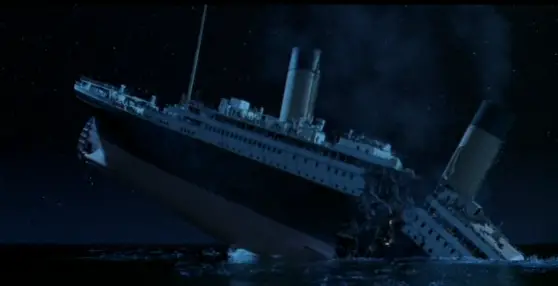
Titanic's split as portrayed in James Cameron's 1997 "Titanic" film.
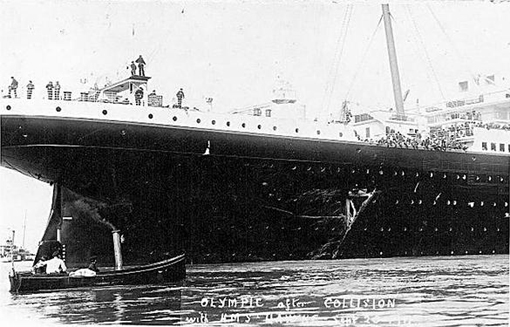
Damage to Olympic caused by its collision with HMS Hawke.
It clearly occured in a different part of the ship than where the Titanic split.
34. Surviving crew signed the Official Secrets Act
Claim: The surviving crew were detained overnight and forced to sign a pledge under the 'Official Secrets Act', promising to keep secret forever, the actual events of the night of 14th / 15th April, 1912
The origin of this seems to have come from Paddy “the pig”, also known as James Fenton, who late in life related the following:
When the surviving crew got to port they were all taken aside and met by two men, one in a high position in the company, the other man was in a very high position in the Government. The Government man read the crew the “Official Secrets Act’ explaining that if they told of the real reason for the sinking, or the rumours of an insurance scam, they would serve a minimum of 20 years in jail and would never get a job when they got out. Paddy said that the guilt of keeping quiet all those years had taken a great toll on his health and the sanity of the surviving crew.
However, as discussed in point 36 (below), almost certainly James Fenton was not aboard Titanic as he claims. Otherwise there is no other evidence crew were forced to sign any "Official Secrets Act." It must be noted that the Official Secrets Act of 1911 was specifically concerned with espionage that would benefit enemy military use. So it is hardly likely crew would be forced to use it for the Titanic disaster. It is, however, agreed that crew returning to England were under instructions to give evidence at the Board of Trade Inquiry and not to talk to the media beforehand. But this should not misconstrued as being anything unusual, but common practice for a company which suddenly comes under media scrutiny and wants to maintain damage control, especially prior to an official inquiry.
35. Harold Sanderson repeatedly referred to Titanic as Olympic
Claim: Harold Sanderson, from shipbuilder Harland and Wolff, repeatedly referred to Titanic as Olympic at the British inquiry. Was the confusion because they had been switched?
Mr Harold Arthur Sanderson, Director of the Oceanic Steam Navigation Company (not from Harland and Wolff as claimed), was 60 years old at the time of the sinking, and was examined on Day 17 of the British Wreck Commissioner's Inquiry. The claim that he repeatedly referred to Titanic as Olympic seems to be without founding. There is not one occasion in which he seemingly confuses the two in name. The closest we have is when he is questioned about the binoculars and is asked:
19342. We have been told by the look-out people that there were binoculars on the Olympic?
- Coming from Belfast to Southampton.
19343. On the Olympic I am speaking of?
- Oh, I beg your pardon, yes.
19344. And that there were not binoculars on the Titanic?
- Yes.
19345. Oh, I beg your pardon; they were on the Oceanic; but on the Titanic they had been provided coming round from Belfast?
- Yes.
While there is some slight confusion over which ship he is refering to "coming from Belfast to Southampton" there is certainly no evidence here of trying to conceal the identity of the two ships. Even if he did blatantly confuse the names of the ships, it would be clear evidence there was not a 'switch', as otherwise he would have been absolutely sure to get the correct name of the ship to ensure the fraud was watertight.
36. Titanic sailor's deathbed confession of 'switch'
Claim: An old sailor of the Titanic, Paddy “the pig”, revealed shortly before his death that the Titanic was switched with its sistership, the Olympic.

James Fenton, aka "Paddy the Pig".
The story come from Frank Finch, a retired seaman living in New South Wales, Australia, who wrote a letter to the newspaper Northern Star that was published on the 31 July 1996. It was written in response to an article previously published on the 'switch' theory -no doubt due to the release of the book "The Riddle of the Titanic" in 1996. Frank Finch's letter, paraphrases what his son Dennis recalled from a conversation he had in the early 1970s with an old sailor named James Fenton, also known as Paddy Fenton or "Paddy the Pig":

Dennis Fench, who relayed the story told to
him by "Paddy the Pig".
In 1912 Paddy [claimed he] was a 22-year- old ordinary seaman aboard Titanic. He always maintained that the iceberg alone did not sink Titanic, that it had a fire burning in the coal bunkers for a week and that the Captain and the company knew about it. Paddy also said that when the crew joined Titanic there was [sic] rumours that the company had switched ships at layup and that an insurance scam was going on. They sailed in a great hurry from Belfast and said that when they hit the iceberg it did not do serious damage but when the cold water hit the coal fire, it exploded and caused the fatal damage. The Chief Mate put Paddy in charge of a lifeboat, keeping older hands on deck for lowering boats. When the surviving crew got to port they were all taken aside and met by two men, one in a high position in the company, the other man was in a very high position in the Government. The Government man read the crew the “Official Secrets Act’ explaining that if they told of the real reason for the sinking, or the rumours of an insurance scam, they would serve a minimum of 20 years in jail and would never get a job when they got out. Paddy said that the guilt of keeping quiet all those years had taken a great toll on his health and the sanity of the surviving crew.
Steve Hall and Bruce Beveridge investigated this account in their book Titanic or Olympic: Which Ship Sank? and came to the conclusion that while elements of Fenton's background can be validated there is no proof that a man of that name was ever aboard Titanic; his name is not any of the crew lists or among any of the survivors lists . Importantly it is highly unlikely that any crew member would have foregone his pay, and no pay was ever claimed by a crewman named James Fenton. Also, a coal bunker fire was indeed burning on Titanic, although it was put out before the collision and in any case as it is not explosive amd would not have caused the damage described. It is not surprising that even Frank Finch doubted the third hand story he relayed.
37. The number 401 on Olympic woodwork
Claim: Panelling from third class areas of the ship now adorn a private flat in the Wirral. This woodwork has the reverse sides clearly marked. On the panels the number 400 is stencilled, but on the frames the number 401 is clearly visible.
Without further information or documentation on this "private flat in the Wirral" -even a photograph - it is difficult to examine the evidence (if there is any) but needless to say it does sound like hearsay and an attempt to offset the evidence that the number 400 (Olympic's number) is all over Olympic's woodwork (see more information on this here).
38. Olympic's name is on the wreck
Claim: The forged "Titanic" letters have rusted off and reveal a "MP" - part of the word Olympic that was actually engraved or embossed into the original metal panel of the ship.
This particular claim began when Robin Gardiner stated in his book that when the name on the bow of the Titanic wreck was cleared of rust (allegedly filmed by Dr. Ballard during his 1986 dive to the wreck), the raised letters 'M, P & Y' were visible. However, he does not show a picture of this, nor does he offer any source for this assertition at all. Sometime later in a documentary entitled "Titanic - The Shocking Truth" the following image appeared:

A clearly fake computer generated image
of the letters M and P on the wreck.
Some have analysed the footage concluding for example that the X-shaped viewing field seen in the video is caused by the camera rig's lighting. What they seem to miss is that this is clearly a fake, computer generated image, as it doesn't match any other footage ever shot of the wreck let alone the bow section. Not to mention that the name Titanic was first filmed on the wreck in 1987 and it certainly does not look anything like this. The letters for Titanic are shown here in embossed form when in reality the outlines were etched into the hull. Of course there is no testimony from Ballard himself, or from any of the other expeditions who would clearly have also seen this.
Interestingly, Gardiner himself has admitted the image is fake. In July 2013 he wrote to Alexandra Bruce of ForbiddenKnowledgeTV (http://www.forbiddenknowledgetv.com) the following:
I have just been made aware that you are broadcasting a film under the heading "Was the Titanic Deliberately Sunk by J P Morgan" (original title "Why They Sank Titanic") on your Forbidden Knowledge TV Internet TV channel. This film was made by Mr Andrew Newton back in 2000... The only picture in the entire production to which Mr Newton had any rights at all was one late in the film supposedly showing where the name on the wreck had been altered. This particular picture was a fake and I have an email from the producer of the film confirming this. (http://www.forbiddenknowledgetv.com)
The most telling aspect of this either unintentional -or possibly intentional- forgery, is the desperate need to do it. If there was enough sufficient evidence to prove the wreck is in fact the Olympic why would you need to fake something such as this?
Compare the two videos below -one is the real footage of the Titanic name on the wreck, one is fake. Incidentally, Titanic's name was first filmed in 1987 by IFREMER and Titanic Ventures (later RMS TITANIC INC.) after they cleaned that part of the bow from rust.
Allegedly footage of Olympic's name on the wreck.
Video footage of Titanic's name clearly visible on the wreck in 1987.
39. 401: Titanic's propellor is on Olympic
Claim: Olympic was fitted with Titanic’s propeller
The claim that Olympic was fitted with Titanic’s propeller has been made as a defense for the fact that the propellor on the wreck has Titanic's number on it: 401 (for more information see here).
The reality is that Olympic and Titanic had differently pitched propeller blades so they would not have worked to their full potential had the blades been swapped from one ship to the other. But also there would be no need to. We know that Titanic had spare propellors made (as after the disaster they were used for memorials) so it would not be unreasonable to expect Olympic was the same.
Mark Chirnside summarises: "Olympic was fitted with Titanic’s starboard propeller shaft. There is no evidence that Harland & Wolff ever used one of Titanic’s propellers, or propeller blades, on Olympic; there is every reason to believe that they would have had a spare Olympic propeller in any case."

The number 401, Titanic's shipyard number, is also on the Titanic's starboard propeller.
40. White paint on the wreck
Claim: The Olympic's hull was painted white for its launch so that it would show up in photographs better. Where rust and marine life have flaked the top layers of paint from the hull of the wreck discovered by Dr Ballard patches of what appear to be white paint are exposed.

This image allegedly shows 'hull plating from the wreck
showing white and light grey paint showing through
the black top coat'.
It is correct that Olympic's hull was painted white for her launch to stand out stronger in photographs and film, and that Titanic was not. And there is evidence of white paint on the hull of the wreck. But this is not due to it being the Olympic. Actually it is quite simply medium gray primer that was used on all three Olympic class ships, including Titanic, showing through, but which under the harsh lighting conditions looks more white than gray.
41. Marble in the Sitting Room
Claim: When James Cameron sent a robot in to Ismay's room it filmed a veined marble surround on the fireplace that exactly matches that shown in a photograph of the corresponding stateroom aboard Olympic, taken in 1911.
According to the documentary "Titanic – Breaking New Ground", James Cameron sends a robot submarine into the sitting room of the promenade suite on B deck and films the cast iron fireplace with its veined marble surround to still be in place. Veined marble is a naturally occurring metamorphic crystalline limestone and, like snowflakes and finger prints, no two pieces are the same. However, the marble filmed on the wreck exactly matches that shown in a photograph of the corresponding stateroom aboard Olympic, taken in 1911.
Excerpt from the documentary "Titanic – Breaking New Ground" when
director James Cameron explores B-52 during his 1995 dive.
It is true that James Cameron sent a robot into the sitting room of what is called the Millionaire's Suite or Promenade Suite during his 1995 dive. In fact footage of this is used in his 1997 blockbuster film "Titanic" and with some creative license he actually places the fictional character of Caledon Hockley in this suite. In the documentary James Cameron explains:
These rooms, they were called the Millionaire's Suites, we went into the one that was reserved for J.P. Morgan. To be able to go into that room and see that marble fireplace still sitting there and to be able to compare our video with a period photograph of the time and look at the veining in the marble and realise it is the same thing, it was like a fingerprint. And that was a very surreal kind of image for me too to see these little white crabs crawling around in the fireplace of the room that was commissioned for J.P.Morgan.
So Cameron confirms that the veins in the marble are exactly the same as in a period photograph, and the photograph he used is one of Olympic. Has Cameron in fact admitted that Titanic is actually Olympic? No, and for one very simple reason: it is a marble faux fireplace. 'Faux' as in false or imitation. It came from a mold and so there should be no surprise they are exactly the same, that is what you expect from faux marble. To confirm this Parks Stephenson visited the B-52 with James Cameron on a later mission in 2001 and described the room as still retaining "several of its fittings. Against the forward steel wall, the marble faux fireplace with its bronze details seems in perfect condition." Titanic researcher Ioannis Georgiou explains further:
"Ismay's sitting room was explored by James Cameron during his 2001 dives. The fireplace filmed in 1995 and which partly was shown in the "Titanic" movie at the beginning were actually the fireplace of sitting room B 51 which was occupied by Mrs. Cardeza and her son. In the movie the fireplace was a mixture of the fireplace in B 51 (Cardeza) and C 55 (Straus) and was representing a "new" sitting room B 52 (the complete room became nearly a copy of C 55) which never existed on the original ship...Furthermore the fireplaces were in different places. On Olympic the fireplace was at the outer wall between two windows. As Titanic had a private promenade behind it the fireplace was moved to the "forward" wall this can be also seen on photographs taken by the press on board Titanic on April 10th 1912 a few hours before her departure and also today in the wreck."
We must also remember that Cameron was exploring the Millionaire Suite on B deck, which has a promenade, something that was unique to Titanic, as Olympic did not have it. So in fact rather than proving a 'switch,' exploration of this suite only confirms that it is indeed Titanic that sank.
42. Ship's Bell with no name on it
Claim: Olympic could not go to sea as Titanic with Olympic written on the bells. The answer was to grind the names off the bells. One of the ship’s bells was recovered from the wreck but, although in excellent condition, there was no name on it.
Mark Chirnside writes regarding the bell in his dissertation:
"The absence of a name on this bell does not prove that the ship was the Olympic. Nor does it prove Gardiner’s speculation that the name had been ground off the bell. In fact, according to American researcher Jon Hollis, the bell recovered from the wreck was actually the crow’s nest (or lookout) bell, and he states: ‘on ships the crow’s nest bell seldom has any writing on it.’"
43. Bulkhead put on Olympic found in stern wreck
Claim: The stern section of the wreck has a longitudinal bulkhead, that looks like a temporary repair had been made to strengthen the keel, exactly what had happened to RMS Olympic.
Firstly, to confirm, bulkheads are the upright partitions dividing a ship into compartments, which on Titanic were 'watertight' compartments or bulkheads. However, this was not unique to Titanic. In fact all ships of the Olympic Class (i.e. Olympic, Titanic and Britannic) all had watertight bulkheads so it would certainly not be unusual to discover a bulkhead in the stern of the wreck of Olympic, Titanic or Britannic and certainly does not prove a 'switch'.
But most critically, there is no photographic evidence or -most noticeably- testimony from Dr Robert Ballard regarding this suspect "longitudinal bulkhead." When or where did he ever say he discovered this? Where is the photograph? Without this such an allegation can simply be filed under 'hearsay.'
VWhen questioned about the switch theory at the Belfast Titanic museum Q&A in 2014, the man who discovered the wreck of the Titanic, Dr Robert Ballard answers: "I think it is the Titanic at the bottom of the ocean."